Don't wanna be here? Send us removal request.
Text
What is Career Planning, Importance & Major Steps
Having the appropriate job and being in the right place at the right time go hand in hand. Having the career you want is more about career planning than luck, even if hard effort certainly plays a part.
By creating a career plan, you may decide on the path you want to take and then take the necessary action to get there. Furthermore, rather than the other way around, a career plan empowers you to take charge of your professional destiny.
What is career planning?
Career planning refers to the active management of your career and the methodical planning of its future. Your personality, skill set, and ideal function should all be taken into account while planning your career, in addition to the shifting demands of the labor market.
When you plan your career, you choose a path that will fulfill your goals and satisfy your financial, emotional, and otherwise needs. Making better decisions for yourself is the key to living the life of your dreams.
Consider this: a person with a full-time job will work a third of their day at their place of employment for most of their young life. This work may have a negative impact on happiness and health if it is not chosen carefully. Career planning is an effort to create your existence.
Career planning goes beyond selecting the perfect career path. It also involves planning how you're going to get there and what you'll need to get the job. Since this process takes time for most of us, career planning takes one's long-term trajectory into consideration. Make your career secure with the best graphic designing course in Jaipur at Beyond Animation.
Importance of Career Planning In 2024
Imagine someone with no plan at all to get an idea of the significance of career planning. They accept what is offered, not actively seeking the most significant opportunities. When labor becomes monotonous, they don't think about what could be done differently; instead, they accept it as a given.
That person lives life to the fullest, reaches their full potential, and realizes their wildest dreams. Work plays a vital role in our daily lives and shouldn't be left to chance, even though it's not the only thing that matters.
5 Steps of Career Planning
1. Evaluate Yourself
To help you decide not only what you'd like to accomplish but also where you'd like to do it, start by evaluating your values, interests, and abilities. This is how that seems.
Find out for yourself what interests you. What is your strong passion? What sparks your interest? More significantly, even without compensation, what would you like to do all day, every day, for years? If you can't think of anything, consider your extracurricular and hobby activities.
Start your career in web designing with the dedicated web designing course in Jaipur by Beyond Animation.
2. Research the Possibilities
Once you've decided what to accomplish, look at the opportunities in your desired field.
Look through open openings and find a job title that seems a good fit for you. Do the job descriptions and advertisements sound like something you would like? Next, investigate industry companies to find out more about them. Do their goals and principles match with yours?
However, don't restrict yourself to business websites and authorized press releases. Even if these are excellent resources, try to discover more about what "a day in the life" entails in this line of work. Look for social media posts or Glassdoor reviews to gain an insider's perspective of the organization and the position.
3. Make Plans (and Do Them)
It's time to set goals and take action when you've decided on a career.
A combination of short-, medium--, and long-term objectives should be made. Your short-term objectives are those that you can complete in 30 days to 6 months, your medium-term objectives will take 1 to 3 years, and your long-term goals can take up to 10 years.
4. Be Adaptable
A career plan provides a structure to reach your objectives, but it's essential to ensure the plan is adaptable. You have to make adjustments because you never know when things will change.
5. Good Luck Precedes Upon the Knowledgeable
Certain aspects of your job may be random, but it's much more likely that conscious career planning has shaped who you are and where you're headed. Your career planning investment is an investment in yourself since it will enable you to choose the professional path that best suits your needs and brings you happiness.
How to Apply for Your Chosen Career?
Make or update your CV or resume to emphasize your education, employment history, talents, and credentials. Ensure your CV or resume matches the job you are applying for.
When writing your cover letter, avoid appearing overly superficial. Think about putting yourself in the position of the potential employer and assessing your cover letter based on their reaction or emotions.
Make your career in photography with a Photography Course in Jaipur by Beyond Animation.
FAQs - Importance of Career Planning in 2024
Q1. Does career planning work?
Ans: Yes, without a doubt! It is effective for people who follow their career planning exactly. It is a road map that shows what a person excels in, his interests, shortcomings, and areas of strength and weakness. It also shows how he might use his skills to reach various professional milestones.
Q2. What makes a career timeline important?
A career timeline is a road map that shows which goals to pursue at what times. It can help individuals find the best paths to achieving their job goals by giving them direction and clarity.
0 notes
Text
What is the Future of Graphic Design in 10 Years?
The graphic design industry has always been dynamic, adapting to technological advances and shifting design trends. As we look ahead ten years, the future of graphic design is full of exciting opportunities.
This blog focuses on upcoming ideas and technologies that will affect the role of graphic designers and the industry, ranging from immersive experiences to virtual reality, artificial intelligence, and sustainable design.
● Increased Demand for Graphic Design
The demand for graphic design will increase significantly during the next decade. Indeed, there will be an increase in demand for graphic design courses! With the continued expansion of online platforms, social media, mobile applications, and digital marketing, businesses will rely more on graphic designers to provide visually appealing and user-friendly digital experiences. Designers must understand responsive design, interactive interfaces, and content optimization for different devices and screen sizes.
● Integration of Augmented Reality (AR) and Virtual Reality (VR)
AR and VR technologies are fast evolving, and their incorporation into contemporary graphic design approaches will transform how we view and interact with visual content. Graphic designers will be essential in creating immersive and interactive experiences, whether designing AR filters, VR settings, or virtual product demonstrations. Graphic designers will be in high demand for their ability to integrate the digital and physical worlds effectively. The future of graphic design looks good.
● Welcoming artificial intelligence (AI)
When you look at the future of graphic design, artificial intelligence can automate monotonous activities, allowing designers to focus on more strategic and creative aspects of their job. AI-powered technologies can generate new graphic design styles and variations, optimize layouts, and even recommend color schemes based on data analysis. Graphic artists should become proficient and understand how to interact with AI tools to increase their productivity and creativity. Beyond Animation offers the best Photoshop course in Jaipur; enroll now on the website!
● Innovative Design and Moral Standards
In the future of graphic design, As society becomes more eco-conscious, there will be a greater demand for sustainable design solutions. Graphic designers must include eco-friendly principles, taking factors such as recyclability, carbon footprint reduction, and ethical material sourcing. Designers will also be essential in promoting social responsibility, inclusivity, and diversity via visual communication.
● Personalization and user-centered design
Personalized and user-centric design will be essential in the future. With a wealth of data and developments in user tracking, graphic designers will gain vital insights into their target audience. They will be responsible for developing tailored visual experiences that resonate with individual users through customized interfaces, personalized marketing materials, or adaptive user experiences.
● Collaboration Design and Remote Work
The future of graphic design is the rise of remote work and digital collaboration tools, which will continue to shape the graphic design business. Designers will work with clients and colleagues all across the world. Therefore, effective communication and project management abilities are required. In the coming years, graphic designers must be able to collaborate smoothly across time zones and cultural boundaries.
● Budding Designers Need to Learn and Develop Adaptability Continuously
To succeed in the future, graphic designers must embrace lifelong learning while adapting to new technology and design trends. The industry will evolve quickly, and remaining current on innovative tools, software, and approaches will be critical. To keep current, designers need to continue professional development, attend workshops, and participate in online networks for a better future of graphic design.
● Data Visualization and Infographics
With the exponential data growth, there will be a greater demand for graphic designers who can convert complex information into visually appealing and simply understandable formats. Data visualization and infographics will be crucial in efficiently communicating information, making it visually appealing and accessible to various audiences.
● Motion Graphics and Video Content
Video usage is the future of graphic design and is on the rise, so graphic designers must adapt to this trend. Motion graphics, Animation, and video editing abilities will be in great demand as designers create visually appealing stuff for social networking platforms, websites, and multimedia presentations.
● Future of Graphic Design: Entrepreneurship & Freelancing
With the development of the gig economy and remote work, more graphic designers can choose to work as freelancers or create their design businesses. Developing entrepreneurial abilities, such as marketing, client management, and financial management, will be critical for designers seeking to prosper in this context.
The future of graphic design offers an exciting and innovative sector fueled by technology, user-centric design, and sustainability. As digital platforms grow, augmented reality becomes more popular, and artificial intelligence progresses, graphic designers will be at the forefront of designing exciting visual experiences.
By pursuing a graphic design course in Jaipur beyond Animation, you will be able to gain hands-on experience and contribute to society more creatively. Graphic designers may open new opportunities, collaborate across boundaries, and create the future visual environment by working alongside developing technology, focusing on sustainable practices, and honing creativity. It's an exciting moment to be a graphic designer, and those who can adapt and embrace change will succeed in the coming decade.
What's the Next Future of Graphic Designers?
● Putting Users First:
It will be essential to design meaningful user experiences, ensuring that every interaction is intuitive and engaging.
● Exploring New Realms with AR and VR:
As augmented and virtual reality grows more popular, graphic designers will focus on developing immersive experiences that blur the line between reality and fantasy.
● Designing Responsibly:
With a rising emphasis on sustainability, graphic designers will promote eco-friendly solutions while minimizing their environmental impact.
● Adopting Automation:
By leveraging the power of AI and automation, graphic designers will streamline operations and open up new avenues for creativity.
Choosing to learn graphic design from a reputable Institute that offers graphic design courses and Adobe InDesign training course in Jaipur is essential in preparing for your future. Beyond Animation offers more than just education; we also provide crucial insights, mentorship, and industry exposure, all necessary for success.
0 notes
Text
Importance of Typography in Graphic Design & Why is It Important for Graphic Designers?
Let's start by recapping the definition and applications of typography before we get started. Typography is the deliberate placement of type to enhance written language's readability and aesthetic appeal. One of the most essential skills that any graphic and online designer should possess is the art of typography. It is crucial to all forms of design, digital and print.
In graphic design, typography serves two primary functions. The first is to make a design piece more readable, and the second is to aid in conveying the design's message, tone, and emotion. Aesthetics is another role that typography plays. Clear, aesthetically pleasing designs that are easy on the eyes lure us in. On the other hand, we avoid cluttered, complicated designs that strain our eyes. Thus, learning to use typography in graphic design efficiently is in our best interests and our client's best interest.
What is Typography in Graphic Design?
What is typography? Typography is, at its most fundamental, the skill of arranging typefaces in different font, size, and spacing configurations. In this approach, the effective use of typography is essential for creating an impact in a wide range of designs, such as print design, computer graphics, books, brochures, and websites.
Typography is a tool graphic artists use to modify text in their designs. This facilitates the production of purposeful content. Designers can create an aesthetically beautiful design by strategically using typefaces.
Designers have deliberately employed typefaces to enhance readability and impact on viewers. Such designs with original typographic concepts enable brands to communicate effectively with their target market.
Designers can generate pictures for brands using typography in graphic design. When utilizing typography, graphic designers take into account a few essential factors. They choose fonts carefully, considering factors like body text, white space, font size, placement, and many other aspects of employing a typeface. Be the best in graphic designing with the best graphic designing course in Jaipur by Beyond Animation.
Basic Rules Of Typography in Graphic Design for Designers
Typography serves a purpose for graphic designers. The designers must learn to use typefaces creatively because they want to convey a particular brand message to a target audience.
Specific graphic designs are text-only in nature. To create visually appealing and functional graphics, expert designers adhere to a few well-established typographic guidelines. Here's what they think about:
Examine the Text - Typography in Graphic Design
First, a skilled graphic designer will carefully study the customer's complete material.
This makes text all the more crucial when using it in website design. A typical error designers make is copying and pasting text from a file.
However, selecting the incorrect typeface and font will not aid in making the desired impression on visitors or buyers. Therefore, read the content to the end to obtain a distinct notion of how it should be merged and integrated into a website design to catch customers' or visitors' attention. Therefore, carefully read the entire text before deciding on the appropriate typographic element. Photoshop skills are critical in graphic design, so learning fundamentals is essential. Enroll in a Photoshop course in Jaipur to learn from the best at Beyond Animation.
Display the Hierarchy - Typography in Graphic Design
The goal of hierarchy is to direct the viewer's attention to the most significant component of the design, in this case, the website design. The designer uses the typeface to determine which area a visitor should read first. The designer uses font size and typeface to draw the eye and highlight the most crucial information to establish a hierarchy.
Adding three distinct layers of typography to a design is typically how designers establish an effective hierarchy. The most important content is usually the level-one typography. This is where viewers notice your design's first distinctly noticeable typographic element.
The level-two typography element is utilized to group or segment the text to make it easier for users to explore the details. However, this typeface level ought to be distinctive.
The level-three, primarily a text-heavy layout, is typically the heart of the design. This is where the viewer engages with your design's message. It might be a synopsis or your entire essay.
At this level, the main goal of typography in graphic design is to facilitate reading because the font size is typically modest.
Choose Typefaces With The Correct Colors - Typography in Graphic Design
The designer perfectly coloured the font, making it easy to read.
Using colour draws a visitor's attention to a website or other design that is much more accessible. If the typeface colour is chosen incorrectly, the backdrop design components may cause the viewer to lose focus.
As a result, the colour chosen by the designers and typographic artists differs from the background colours. For example, use the black font on a white or light-coloured backdrop to make the writing readable.
Make an impact - Typography in Graphic Design
A powerful visual effect can be produced by typography. In graphic design, there are numerous methods to use typography creatively to leave an impression on the spectator. It can even be applied in a way that effectively communicates the design's message without the necessity for additional supporting images.
Some Illustrations of graphic designs where typography takes centre stage and has a strong effect. It takes great artistic talent and skill to achieve the impression of the typography in these examples; it is essentially art. Start your career in digital illustration with the best digital illustration course by Beyond Animation.
Why is Typography in Graphic Design so Important to Graphic Designers?
The designer perfectly coloured the font, making it easy to read.
Using colour draws a visitor's attention to a website or other design that is much more accessible. If the typeface colour is chosen incorrectly, the backdrop design components may cause the viewer to lose focus.
As a result, the colour chosen by the designers and typographic artists differs from the background colours. For example, use the black font on a white or light-coloured backdrop to make the writing readable.
0 notes
Text
How to Get Into UX Design | UX Designer Jobs You Could Get
The discipline that focused on enhancing usability was formerly known as "human interface research," but it is now more often recognized as user experience design or UX. However, the 1980s PC revolution and following the twenty-year internet boom altered the ways in which the tech sector focused on usability and interface design. The word UX was first used by UX pioneer and 1993 Apple Fellow Donald Norman, who urged the industry to use the phrase to represent the more comprehensive nature of this evolving approach.

With a remarkable increase anticipated in the upcoming ten years. But what exactly does a UX designer achieve in today's world? Please continue reading to learn how to become a UX designer and how we interact with the digital devices we use on a daily basis.
What Is UX Design?
The process of designing an engaging user interface (UX) for a product or service is known as UX design. Effective UX design focuses on customer needs and facilitates users in completing activities and achieving objectives with ease.
The success of a product is determined by how well its UX design works. A well-designed product will increase brand loyalty while drawing in, converting, and keeping target consumers. Along with lowering maintenance and development costs, good UX design also makes products more accessible and user-friendly.
What Is a UX Designer?
UX designer jobs are to create user-friendly, visually beautiful forms that solve user issues through straightforward, intuitive interaction experiences. Designers need to be aware of user expectations, pain spots, attitudes, motives and wants in order to produce a great user experience. UX designers look at the reasons for user adoption, the main goals users have for using a product, and the attitudes users have about the product itself. Product design and functioning are informed by these observations. Learn graphic designing now in Jaipur, Graphic designing course in Jaipur by Beyond Animation.

Let's look at how experience might affect UX designer jobs and responsibilities.
Entry-Level UX Designer Jobs
A lot of junior designers start as generalists. Entry-level UXers carry out given or blueprinted tasks to assist mid- and senior-level designers. In their teams, entry-level designers can come across mentors who could help them learn by doing.
Mid-Level UX Designer Jobs
Typically, mid-level UX designers specialize in a certain sector or product type as their area of expertise. Mid-level designers examine design choices from a features- or project-level perspective, paying less attention to specific details. In addition to possessing deep knowledge of design techniques and tools, mid-level designers face a higher level of responsibility for user experience efforts.
Senior-Level UX Designer Jobs
Senior UX designer jobs in which holders often have more than six years of experience and approach assignments with an abstract, high-level perspective. These experts are aware that changing one component of a system will have an impact on the other components as well. Senior designers focus on the connections between business models, product design, and human behaviour, seeing designing for a variety of devices and platforms as just contextual variations.
A Day in the Life of UX Designer Jobs
A UX designer's daily tasks change based on the responsibilities of the position and the UX design process. While a specialized UXer at a major firm could concentrate on only one design phase, a generalist UXer at a startup might take part in all of them. Get certified in illustrator through the dedicated illustrator course in Jaipur by Beyond Animation.
User Research
The goal of user research is to comprehend the psychology and behaviour of users. These revelations assist UX designers in seeing design possibilities, verifying presumptions, and developing empathy for the user experience of a product.
While quantitative research examines the statistical significance of these data, qualitative research looks into the attitudes, actions, and requirements of users. Using user personas—which are fictionalized depictions of significant sectors of a product's target market—designers are able to leverage this data. Designers can better customize products to meet specific demands by using user personas.
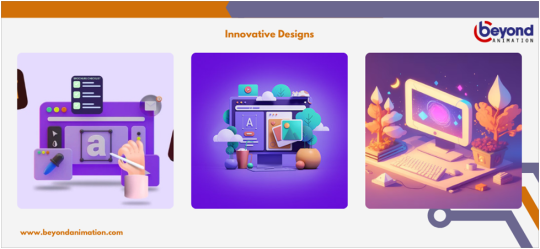
Personal Development
UX design is a developing field. To keep track of new UX trends, designers read newsletters, listen to podcasts, and follow UX thought leaders on social media. Behance and Dribble are two examples of online design communities that provide designers with the chance to expand their professional networks and discover inspiration.
Prototyping
Interaction design is emphasized in prototypes. Low-fidelity prototypes focus on communicating the main features, information architecture, layout, and screen flow of a product rather than technical specifics. Prototypes with high fidelity include sophisticated interactive features like scrolling and responsive menus, along with user interface components like colour, graphics, and animations. These prototypes functionally simulate the final product.
User Testing
In UX designer jobs, they evaluate high-fidelity prototypes to confirm their design choices. Designers can determine the effectiveness of features, functionality, and other aspects through user testing. Analyzing how users engage with a product can help identify areas of difficulty and guide improvements in future versions. While quantitative testing establishes the problem's breadth and size, qualitative testing pinpoints the locations of issues and the reasons for user difficulties. Moderated or unmoderated user testing is possible.
UX Design Skills to Get UX Designer Jobs
Hard Skills for UX Designer Jobs
Hard skills are the specific technical know-how and education required to carry out UX design. Among the hard UX design talents are:
Prototyping and Wireframing
Wireframes and prototypes are made by UX designers using digital tools such as Sketch, Figma, InVision, or Adobe XD.
User Research
Research abilities are required to determine user demands. To gather information about their target audience and create user personas, UX researchers employ a variety of approaches, including diary studies, interviews, questionnaires, and more.
Visual Communication
Designers employ visual components to communicate or arrange information, increase product navigability, elicit strong feelings, and strengthen recognition.
Soft Skills for UX Designer Jobs
Soft skills are character attributes and people abilities that facilitate communication and collaboration between designers and users. Learn how to create an attractive website with a web designing course in Jaipur by Beyond Animation. Among the soft UX design abilities are:

Empathy
In order to create designs that provide users with worthwhile, enjoyable experiences, designers must employ emotional intelligence to understand user demands, desires, motivations, and pain points.
Communication
In order to create designs that provide users with worthwhile, enjoyable experiences, designers must employ emotional intelligence to understand user demands, desires, motivations, and pain points.
Collaboration
Designers frequently collaborate in groups. A cooperative mindset produces better answers and quicker advancement.
Visit Website :-
0 notes
Text
Mastering the Art of Image Editing: A Comprehensive Guide to Learning Photoshop
As the gold standard for image editing and manipulation, Adobe Photoshop is a must-have skill for creatives looking to excel in graphic design, photography, and digital art. With its vast array of tools and features, Photoshop can seem daunting to beginners, but with the right approach, anyone can master this powerful software. In this blog, we'll take you on a journey to learning Photoshop, covering the basics, advanced techniques, and expert tips to help you unlock your creative potential.
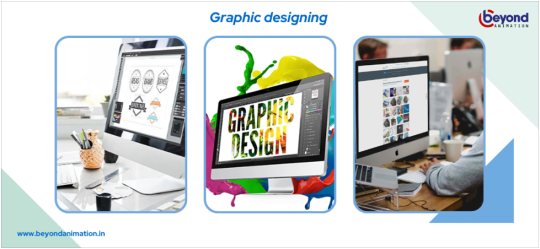
Why Learning Photoshop is a Must for Graphic Designers
Photoshop is an indispensable tool for anyone working with images. Whether you're a professional photographer, graphic designer, or social media influencer, learning Photoshop can help you:
Enhance your pictures: Improve the quality and aesthetic of your photos with advanced editing techniques.
Increase productivity: Streamline your workflow with Photoshop's powerful automation tools and shortcuts.
Stand out from the competition: Create unique and captivating visuals that set you apart from others in your field.
Boost your career: Develop a valuable skill that's in high demand across various industries.
Getting Started with Learning Photoshop
Before diving into the world of Photoshop, it's essential to understand the basics. Here are some key concepts to get you started:
Understanding the interface: Familiarize yourself with Photoshop's layout, including the toolbar, menu bar, and workspace.
Basic selection tools: Learn how to use the marquee tool, lasso tool, and magic wand to select and manipulate objects.
Layers and layer masks: Understand how to work with layers, layer masks, and blending modes to create complex compositions.
Basic adjustments: Learn how to make basic adjustments to brightness, contrast, and color balance.

Advanced Techniques for Learning Photoshop
Once you've mastered the basics, it's time to take your skills to the next level. Here are some advanced techniques to help you become a Photoshop pro:
Layer blending modes: Experiment with different blending modes to create unique and captivating effects.
Masking and compositing: Learn how to use layer masks and compositing techniques to create realistic and seamless compositions.
Retouching and restoration: Develop your skills in retouching and restoring images, including removing blemishes, noise, and artifacts.
Advanced selection techniques: Master advanced selection techniques, including using the pen tool, select and mask, and focus area.
Learn Photoshop from Beyond Animation offers the best Photoshop course in Jaipur.
Expert Tips for Learning Photoshop
Visit Website :-
0 notes
Text
Mastering the Art of Image Editing: A Comprehensive Guide to Learning Photoshop
As the gold standard for image editing and manipulation, Adobe Photoshop is a must-have skill for creatives looking to excel in graphic design, photography, and digital art. With its vast array of tools and features, Photoshop can seem daunting to beginners, but with the right approach, anyone can master this powerful software. In this blog, we'll take you on a journey to learning Photoshop, covering the basics, advanced techniques, and expert tips to help you unlock your creative potential.
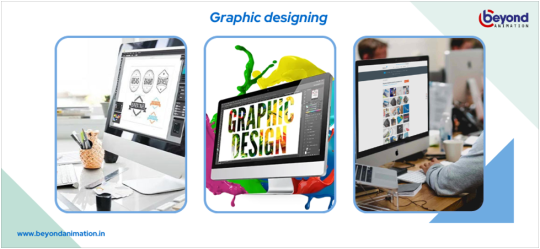
Why Learning Photoshop is a Must for Graphic Designers
Photoshop is an indispensable tool for anyone working with images. Whether you're a professional photographer, graphic designer, or social media influencer, learning Photoshop can help you:
Enhance your pictures: Improve the quality and aesthetic of your photos with advanced editing techniques.
Increase productivity: Streamline your workflow with Photoshop's powerful automation tools and shortcuts.
Stand out from the competition: Create unique and captivating visuals that set you apart from others in your field.
Boost your career: Develop a valuable skill that's in high demand across various industries.
Getting Started with Learning Photoshop
Before diving into the world of Photoshop, it's essential to understand the basics. Here are some key concepts to get you started:
Understanding the interface: Familiarize yourself with Photoshop's layout, including the toolbar, menu bar, and workspace.
Basic selection tools: Learn how to use the marquee tool, lasso tool, and magic wand to select and manipulate objects.
Layers and layer masks: Understand how to work with layers, layer masks, and blending modes to create complex compositions.
Basic adjustments: Learn how to make basic adjustments to brightness, contrast, and color balance.

Advanced Techniques for Learning Photoshop
Once you've mastered the basics, it's time to take your skills to the next level. Here are some advanced techniques to help you become a Photoshop pro:
Layer blending modes: Experiment with different blending modes to create unique and captivating effects.
Masking and compositing: Learn how to use layer masks and compositing techniques to create realistic and seamless compositions.
Retouching and restoration: Develop your skills in retouching and restoring images, including removing blemishes, noise, and artifacts.
Advanced selection techniques: Master advanced selection techniques, including using the pen tool, select and mask, and focus area.
Learn Photoshop from Beyond Animation offers the best Photoshop course in Jaipur.
Expert Tips for Learning Photoshop
To take your Photoshop skills to the next level, here are some expert tips to keep in mind:
Practice, practice, practice: The key to mastering Photoshop is practice. Set aside time each week to practice and experiment with new techniques.
Watch tutorials and online courses: Take advantage of online resources, including tutorials, classes, and YouTube channels, to learn from industry experts.
Join a community: Connect with other Photoshop users through online forums, social media groups, and meetups to share knowledge and get feedback.
Experiment and take risks: Don't be afraid to try new things and take risks. Photoshop is all about experimentation and creativity.
Common Mistakes to Avoid When Learning Photoshop
When learning Photoshop, it's easy to fall into common mistakes that can hinder your progress. Here are some mistakes to avoid:
Over-reliance on presets: While presets can be useful, relying too heavily on them can limit your creativity and understanding of Photoshop's tools.
Not saving regularly: Make sure to save your work regularly to avoid losing progress and data.
Not using layers: Failing to use layers can lead to a cluttered and disorganized workspace, making it difficult to edit and manipulate images.
Not understanding color management: Failing to understand color management can
result in inconsistent and inaccurate color representation.
Lightroom or Photoshop: Which is Right for You?
When it comes to image editing, many photographers and creatives wonder whether to use Lightroom or Photoshop. The answer depends on your specific needs and goals. Learning Lightroom is ideal for batch processing, cataloging, and organizing your images, while Photoshop is better suited for advanced image manipulation and editing. By mastering both Lightroom and Photoshop, you'll be able to create a seamless workflow that takes your image editing skills to the next level. Make a career in web designing with the best web designing course in jaipur from Beyond Animation.
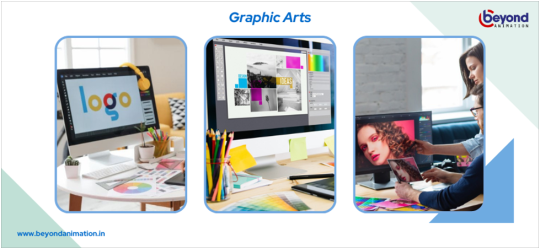
The pros and cons of Learning Photoshop
Particularly when you use Camera Raw, a RAW editor that is quite comparable to Lightroom, Photoshop has a lot of the same functionality as Lightroom. Photoshop is software used for the very end of the workflow and utilized for very particular tasks. But it would help if you never undervalued Photoshop's ability. These are some Photoshop pros and cons!
Pros:
blending of various files for head switching, compositing, sky addition, texture addition, and other layer-dependent components
Adjusting opacity, masking, and blend modes
limitless options for editing
sophisticated tools for adjusting picture quality or expanding the canvas
Improved cloning that quickly eliminates difficult components
Multiple tools for sharpening
Many approaches to making difficult decisions
Process stages can be recorded as actions for convenient recurrence.
Offers capabilities for sophisticated retouching and altering reality's form, such as bending and liquifying.
Photoshop is the application you should use if you want to learn graphic design!
Cons:
Workflow is clunky in comparison to Lightroom. To get a process that is comparable to Lightroom, you need to use Photoshop, Camera Raw, and Bridge.
simpler to alter a single image
Absence of synchronization
It is not as useful for wedding or portrait photographers who are preparing many shots at once.
Possibility of more damaging editing
less natural learning

Conclusion
Learning Photoshop is a journey that requires patience, dedication, and practice. By mastering the basics, intermediate techniques, and advanced strategies outlined in this guide, you'll be well on your way to becoming a Photoshop expert. Remember to stay curious, keep practicing, and always be open to learning new skills. With Lightroom or Photoshop at your fingertips, the possibilities are endless. Start your career with Beyond Animation with a graphic designing course in jaipur. So, what are you waiting for? Start your learning Photoshop journey today and unlock the full potential of this powerful image editing software!
Visit Website :-
0 notes
Text
Unlocking Creativity: The Importance of Summer Graphic Designing Classes
Unlocking Creativity: The Importance of Summer Graphic Designing Classes
As the summer sun shines bright, many students and professionals alike are looking for ways to enhance their skills and stay ahead of the curve. For those interested in graphic design, summer classes can be a game-changer. At Beyond Animation, we believe that graphic designing classes are essential for anyone looking to make a mark in this competitive industry. In this blog, we'll explore the benefits of summer classes for graphic design and why they're a must-attend for anyone serious about a career in this field.

Why Graphic Designing Classes are a Must
In the quickly developing world of graphic design, new tools, technology, and trends develop daily. To stay relevant, designers need to update their skills and knowledge constantly. Summer classes for graphic design provide the perfect opportunity to do just that. By attending graphic designing classes, students and professionals can:
Stay up-to-date with industry trends: Learn about the latest design software, techniques, and best practices from experienced instructors.
Enhance their skills: improve their design abilities in composition, typography, and colour theory.
Build their portfolio: To increase their value to employers, take on new initiatives and expand their portfolio.
Network with peers: Make connections with like-minded people, exchange ideas, and benefit from one another's experiences.
Benefits of Summer Graphic Designing Classes
Attending summer classes for graphic design can have a significant impact on your career. Here are just a few benefits:
Improved job prospects: With updated skills and a strong portfolio, you'll be more attractive to potential employers.
Increased confidence: Gain confidence in your design abilities, allowing you to take on more challenging projects and clients.
Networking opportunities: Connect with industry professionals, potential clients, and collaborators.
Personal growth: Develop your creative skills, critical thinking, and problem-solving abilities.
Who Should Attend Summer Graphic Designing Classes

Summer graphic designing classes are perfect for:
Students: Looking to gain a competitive edge in the job market or prepare for a career in graphic design.
Professionals: Wanting to update their skills, stay current with industry trends, or transition into a new role.
Hobbyists: Interested in learning graphic design as a hobby or to enhance their projects.
What Does a Summer Graphic Designing Classes Teach Students?
You can learn the fundamentals of design and get familiar with the tools graphic designers use to create logos, ads, packaging, and publications by enrolling in a summer graphic design course. Concepts of visual design, typography, pictures, common tools, and branding will all be covered in the course. Soft skills like communication and creativity will also be enhanced. If you are searching for a graphic designing institute, Beyond Animation is the best place for graphic designing course in Jaipur.
Visual Design
The principles of visual design that influence the arrangement of elements to produce a visually appealing and functional design are studied by graphic designers. These guidelines include hierarchy, balance, colour, proportion, and space. Aesthetics is the main focus of visual design, and harmonious features are necessary to prevent the design from seeming "off." A product with good visual design is pleasant, easy to use, and intuitive.
Typography
Typography—the arrangement and spacing of letters—will be taught to the students. Typography is the art of selecting a suitable font and typeface, creating contrast, properly aligning everything, and creating a hierarchy to guide the reader through the work. Graphic designers create text that is readable, clear, and visually appealing by applying their expertise in typography.
Images
Students also learn how to choose pictures and integrate them into designs as part of their graphic design education. You may know how to pick the best picture for a design, where to place it, and how it interacts with the other components surrounding it in a class. You will also learn how to resize, move, and edit photos for layouts.
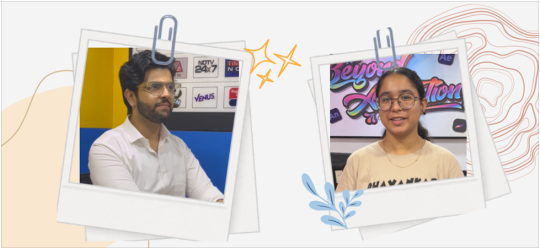
Accessibility
When creating a design, graphic designers must take into account the demands of every user. Aspects of accessibility include navigation, colour, and typography. For example, those with low vision require Graphic Designers to select fonts that are readable and adjust properly for people with low vision. Because some users are colour-blind, colour contrasts should be prominent and should not be the only way to determine when a status change has occurred. The text should be organized into subject-specific sections with bullet points and titles.
Graphic Design Tools
Following a course on fundamental design concepts, you will learn how to use industry-standard design tools. These consist of several programs, including Illustrator, Photoshop, and InDesign, that are part of the Adobe Creative Cloud. Other options are Behance, Canva, and GIMP, which you will learn in summer classes for graphic designing. Learn how to use Adobe InDesign by enrolling in an Adobe InDesign training course in Jaipur by Beyond Animation.
Why Summer Is the Best Season to Take Graphic Designing Classes
Summer is a great time to learn graphic design techniques, regardless of age. Summertime graphic designing classes, though most often connected with summer camps for kids, may also benefit adults, college students, and high school students by providing them with the help and encouragement they need to achieve their long-term objectives. However, anyone wishing to acquire graphic design abilities needs to think about signing up for one of these courses.
Since kids are not in school and might want some guided time to prevent boredom and lethargy, summer is a great time for parents to enroll them in specialized summer training programs. A great approach to fostering a child's creativity is via summer graphic designing classes, which combine supervised teaching with artistic expression.
Students enrolled in these courses will gain knowledge of critical computer skills as well as an appreciation for the sorts of creative activities enabled by tools such as the Adobe Creative Cloud. A creative mind is also important for web designing; beyond animation, offer web designing course in Jaipur at the best prices.

Summer graphic designing classes are a great way for high school students to learn new programs or enhance their current graphic design abilities. When a kid enters high school, they could have a better sense of whether or not they want to continue an arts education. As a result, they can choose their courses more carefully because they won't have to spend as much time studying the fundamentals of what each program has to offer. Because of this, summer training is perfect since the teachings could be customized more to their requirements and interests than the general instruction that younger kids get.
Visit Website :-
0 notes
Text
An explanation of 10 Principles of Animation to Improve your Animation Game
Even with all the efforts made to use computer technology to make animation easier, many artists find it difficult to create visually striking works in this medium. Creating visually stunning animation demands adherence to a certain set of principles. You start by following the rules of physics and the basics of animation, but what about more ethereal concerns like character appeal and emotional timing?

In 1981, Ollie Johnston and Frank Thomas, two talented Disney animators, proposed twelve fundamental animation principles to create more realistic animation. Since then, practically all professional animators have embraced the ideas that some have dubbed the "Bible of animation."
The concepts were initially meant to relate to conventional, hand-drawn animation. However, they are still very relevant to computer animation today and are used in both user experience design and character animation. Best practices to learn animation.
The following twelve principles of animation are taken from "one of the best animation books of all time," The Illusion of Life: Disney Animation, and are shown with examples.
The ten principles of animation are:
Squash and Stretch
Anticipation
Staging
Straight Ahead Action and Pose to Pose
Follow Through and Overlapping Action
Slow In and Slow Out
Arc
Secondary Action
Timing
Exaggeration
Let's explore each principle of Animation one by one.
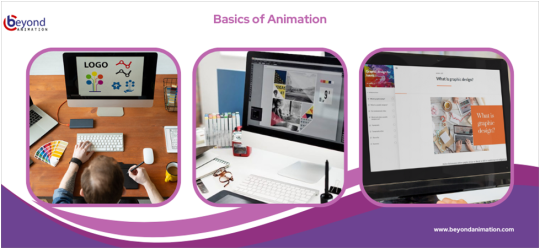
Principle of Animation - Squash and Stretch
Animators use the Squash and Stretch technique to depict the hardness, flexibility, and weight of an object.
When an item falls in an animation, for example, it collapses out when it hits the ground and expands to keep its volume. This demonstrates how adaptable the item is.
In the same way, characters compress and extend their bodies to convey emotions.
The illustration of the Squash and Stretch method in the motion picture The Lion King. When Simba tries a bug for the first time, notice how this method highlights his reactions.
This method gives your scene greater depth and clarity, which makes the animation seem more lifelike. On the other hand, when it is overdone too much, it might become comical. If you are looking for a graphic designing course in Jaipur, Beyond Animation is the best institute to learn graphic designing.
Principle of Animation - Anticipation
In animation, anticipation sets the viewer up for what's going to happen next. It involves a minor motion or action that comes before a major one.
For example, a character will often get momentarily before jumping. Animation's use of anticipation is seen in this squatting action, which alerts viewers to the approaching jump.
This approach gives the animation a natural feel because it mimics the way people move and behave in real life, where minor motions frequently precede our actions.
Principle of Animation - Staging
In animation, staging includes setting up backgrounds, props, characters, and camera angles.
In the Movie The Lion King, the major attention lies with the four people on the stone ledge. The image gradually fills with more features as the camera zooms out, enabling the audience to completely understand the situation.
When there are too many things happening at once, the spectator becomes distracted. Thus, effective staging is essential to a compelling narrative.
Principle of Animation - Straight Ahead Action and Pose to Pose
There are two methods for drawing animations: Pose to Pose and Straight Ahead Action.
Drawing an action frame by frame results in a smooth flow of movement in straightforward action. This technique requires sketching first, usually without knowing the last frame, and then drawing sequentially.
However, this method takes a lot of time because it has to draw several frames for a single operation.
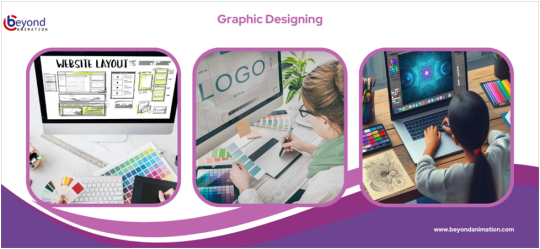
Principle of Animation - Follow Through and Overlapping Action
Two essential techniques used in animation to produce realistic and flowing motion are follow-through and overlapping movement. Even after the character has stopped, several approaches keep certain portions of the character moving.
For example, when a figure wearing a cape runs and stops, both the cape and the person's hair waver briefly before returning to the person. Here, the character's motion is reflected in the cape. The overlapping motion is depicted by the cape and hair's tendency to move at a different pace than the figure. Photoshop courses are top-rated nowadays.
Explore the Photoshop course in Jaipur from Beyond Animation.
Principle of Animation - Slow In and Slow Out
In the real world, things take time to accelerate. They don't suddenly accelerate to 100 miles per hour.
Animators, therefore, make character motions start and end slowly, with rapid movement in between, to produce a more realistic effect. The movement is more realistic because of this variation in pace.
To achieve this effect, animators add extra frames around the start and finish of the action to provide a sense of slow motion. To highlight the speed, they show fewer frames between each other.
Principle of Animation - Arc
The term "arcs" describes how an item or character moves in curves as opposed to straight lines. Humans walk in curved patterns. Even seemingly little actions, like moving our heads, have curving paths. Consider moving your head straight ahead. It's almost disturbingly robotic.
Hence, animators use this curved trajectory motion approach to create a more realistic and organic animation. For instance, a character's sword swing is animated on a curved route as opposed to a straight one.
Principle of Animation - Secondary Action
The secondary action gives the first action more information and improves it. These incidental behaviors may develop a character's personality or show their feelings.
Principle of Animation - Timing
The pace of the scene, which is based on the quantity of frames working, is referred to as "timing." The scene will look slower with more frames used. However, the scene will seem faster with fewer frames.
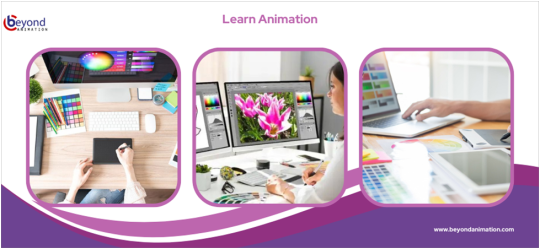
It is important to ensure that the timing of every item in the animation is appropriate for its size and weight. If a character is shown rolling a big ball, for example, the time will change based on the ball's weight. Beyond Animation offers a very affordable web designing course in Jaipur.
Principle of Animation - Exaggeration
Animation with exaggeration is used to improve the narration and produce a dramatic impression.
This approach is used to increase the effect of gestures, attitudes, and even positions.
Animators can also add humor to their work by exaggerating specific aspects of the animation. For example, the situation is funny when a character walks into a pole by mistake and makes dramatic facial expressions.
Visit Website :-
0 notes
Text
Top 8 Advantages of Photoshop in Graphic Designing and Knowing the Uses and Benefits of Photoshop
We have heard about Photoshop a lot, but many people may not be aware of this because they have never used it. What are the advantages of Photoshop?
Graphic designers use many other tools, and no good graphic designer is unaware of Adobe's products. The graphic designers behind every well-known company have a history of creating beautiful branding and eye-catching pictures with Adobe.
Experts use it to design digital images because Adobe Photoshop provides a broad range of tools for making creative and powerful layouts, logos, graphics, 3D artwork, and much more. And it doesn't stop here; Adobe Photoshop's capabilities are constantly updated with valuable options. Professionals modify and enhance the overall appearance of a brand profile by using Adobe Photoshop's highly detailed features to produce an extensive and brand-centric shot.
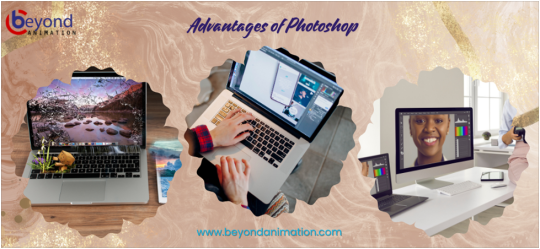
Photoshop allows you to perform various photo alteration, editing, and retouching tasks. You can modify a photo's background, change its colour, colorize a black-and-white image, alter the body of a photo, edit a product shot, sharpen photos, eliminate extraneous objects from any image, and restore old photos, among other things.
Now that you have some understanding of the program. Let's examine the Advantages of Photoshop for graphic design.
Top 10 Advantages Of Photoshop
So Many Tools
With Photoshop, Illustrator, InDesign, and After Effects, among other tools, graphic designers can work on images, vector graphics, and logos; InDesign is used for page layout and typography, and Photoshop is used for image editing and manipulation. With its extensive feature set that serves various graphical requirements, Adobe Photoshop is an ideal choice for any project, whether simple or branding-related. Want a dedicated Adobe InDesign training course in Jaipur? Beyond Animation offers you the best training.
Interface That's Easy to Use
Professionals without IT experience can quickly become proficient with Adobe Photoshop because of its simple interface. Because of the software's simple and easy interface, designers can concentrate on their work instead of finding out how to utilize it. These are the main advantages of Photoshop for graphic design. Moreover, many tutorials and training resources are available in Adobe Photoshop, which can facilitate the rapid upskilling of traditional masters. Are you willing to learn more about Photoshop? There are lots of education centers that offer Photoshop course in jaipur. "Beyond Animation" is one of the leading institutes to learn Photoshop.
.
Industry Standard
For many of the top graphic design firms in the world, Adobe Photoshop is an essential tool. It implies that experts with Adobe Photoshop have the know-how and resources required to finish tasks in the field and create excellent graphic design work, such as making the best Instagram post designs, banners, booklets, and much more.
Integration
Because Adobe Photoshop products are made to function together flawlessly, graphic designers can move between tools without losing any of their work. Experts find this very helpful for complicated tasks requiring several tool sets. Designers may transition between tools using Adobe Photoshop without having to worry about losing their work or compatibility problems. These advantages of Photoshop lead to more efficient working.
Superior Productivity
Because of its high-quality output-producing capabilities, Adobe Photoshop is the ideal choice for those who need to plan work of a high standard. The program has several functions, such as colour correction, sharpening, and noise reduction, that provide designers control over the output's quality. High-resolution graphics are also supported by Adobe Photoshop's features, allowing professionals to produce pictures that work well for both print and digital media. The advantages of Photoshop are countless.
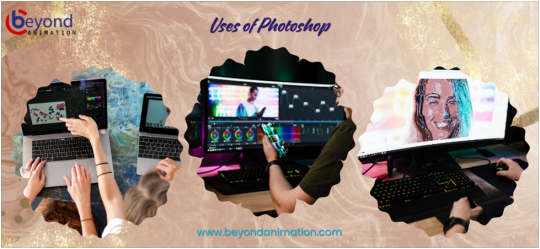
Cloud Integration
Due to Adobe Photoshop's cloud integration, traditional pros may now view their work on any device from any location. Those who operate from various places or are frequently on the go will also find it beneficial. Professionals may work on projects using Adobe Creative Cloud on their laptops, desktop computers, or tablets and access their work from anywhere. This leads to major advantages of Photoshop.
Collaboration
These Photoshop advantages are intended to facilitate teamwork, which is necessary for all tasks, big or small. Graphic designers can share their work with customers or Steam users, facilitating feedback-gathering and change-making. Also, several people can work together on a project using Adobe Photoshop's features, which may speed up the design process and enhance the final product for tasks like Facebook page design services.
Affordability
Various price choices are available in Adobe Photoshop to fit various illustration demands and budgets. Whether you work for an organization or freelancer, Adobe Photoshop offers the appropriate solutions. Moreover, design artists may keep costs down by using Adobe Creative Cloud, allowing them to access the most recent version of Adobe without paying for a break.
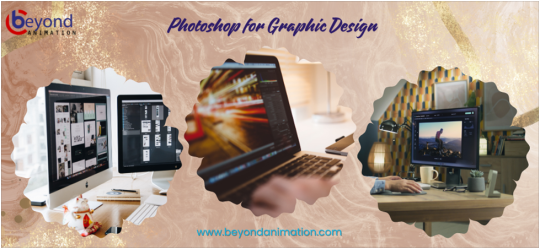
Advantages of Photoshop - Differences from Lightroom
Another Adobe program for editing images is Lightroom. However, Lightroom has fewer features than Photoshop.
Lightroom is an image editing program that allows you to manage your photographs and change their brightness and saturation. However, you cannot change the image in any way, blend it with another source, or apply any processing.
To make your career in the emerging IT sector, Take a web designing course in Jaipur at a very affordable price.
Advantages of Photoshop - Uses of Photoshop
Here are some of the uses and benefits of Photoshop:
Image Writing
Website Designing
Project Layout
Graphics Creation
Pattern and texture styles
Politics and social media
Brand style
Business
Career and jobs
Designing quote pictures
Conclusion - Advantages of Photoshop
Adobe Photoshop is a timeless program that everyone should utilize. It results from Adobe Photoshop's study of original ideas and concepts. Numerous strategies that keep students engaged in their creative work will be taught to them. To help students enhance their talents, schools and computer academics should provide instruction on the fundamental Photoshop and graphics. On the other hand, there are several online applications for Photoshop substitutes. Adobe Photoshop is the finest tool on the market because of its constant innovation and improvement. However, they did a fantastic job creating and experimenting with Adobe Photoshop programs.
0 notes
Text
Mastering the Art of Web Design for E-Commerce: Major Points to Keep in Mind While Building a Successful Online Store
A successful online sales and marketing strategy has always depended on having an attractive and unique e-commerce website design. Web design for e-commerce becomes crucial in differentiating between a challenging and enjoyable consumer experience. E-commerce companies cannot lose revenue due to poor website design when they could make so much.
You have less than a second to make an excellent first impression, and your website design affects 75% of your store's trustworthiness. This implies that reality counts and that perception is essential, especially for your customers.
Web design for e-commerce includes setting up and launching an online store to sell goods. A well-designed website is simple for users to browse and appeals to the intended audience.
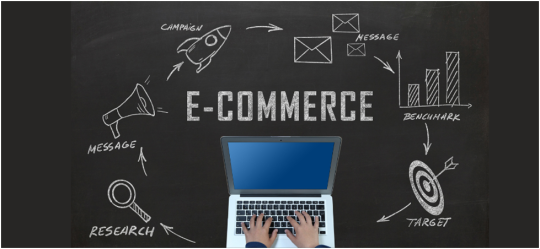
The Importance of Website Design for E-commerce
It is impossible to overestimate the importance of selecting web design for e-commerce. It affects a store's trustworthiness, but in an instant, it also creates the first image that new customers have of it. This highlights that website design is essential in determining customer behavior and e-commerce enterprises' performance. For example, a visually beautiful, user-friendly, and reliable website can result in higher consumer engagement, sales, and brand impression.
In addition to shop reputation and first impressions, good website design directly influences the success of online sales and marketing in the cutthroat world of e-commerce. It is essential to know the web design concepts. As a result, visitors will have a more satisfying and memorable experience, which is crucial for turning them into buyers. Beyond Animation offers a website designing course in Jaipur to help you improve your major skill of web design.
Another crucial component is social media marketing, search engine optimization (SEO), and website design. By combining these components, e-commerce companies may improve their online presence, drive more traffic to their websites, and eventually raise the probability that site visitors will become customers.
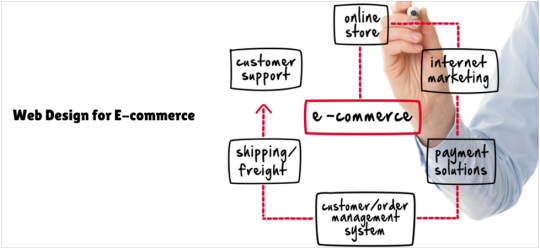
Best Practices Web Design for E-Commerce to Follow:
Your consumers' requirements will determine the style of your online business. Nevertheless, specific requirements apply to all industries.
Consider User Experience When Choosing Web Design for E-commerce.
Your web design for e-commerce is more than just how your shop looks; it's also about how it makes your consumers feel. Your online store has to offer a distinctive experience that forges an emotional bond between your customers and the products you sell. Customers should be able to easily explain their purchasing habits by seeing what you offer in their everyday lives.
Gorgeous images and vibrant colors are great, but the most significant influence comes from prioritizing the client's needs. After a positive user experience, clients are 400% more likely to finish their orders and become loyal customers.
Match brand identity with Web design.
Your e-commerce website is a brand, not just a place to shop. Designing with your brand in mind will guarantee that your store represents a value proposition that attracts leads, promotes customer loyalty, and makes your website stand out. A well-executed design uses consistent language and visuals to tell your brand's narrative. Find out what kinds of product images, fonts, iconography, and color palettes your customers find attractive. Want to do training in web design? Beyond Animation Web Design Institute in Jaipur offers you the best courses on a budget.

Keep informed with Web Design trends.
Due to technological advances, web design for e-commerce is still changing. Data-driven product suggestions, dynamic websites, and interactive design are emerging trends. Customers demand an easy-to-use online experience that lets them browse merchandise, make purchases, and follow orders.
Make mobile-friendly changes.
Customers frequently switch between devices when they purchase online. Using a logical, unified design for mobile devices—desktops, smartphones, and tablets—creates a memorable experience that encourages customers to enter your business. If your web design for e-commerce is not responsive to mobile devices, you may lose out on potential customers. After a bad mobile experience, more than half of users are less inclined to engage with a business, and 67% are more likely to purchase from a store that has a responsive design.

The effect of web design on your e-commerce website
creates a powerful first impression
Web design for e-commerce creates a powerful first impression. The way the website is designed has a significant impact on this perception. Well-organized and professional-looking designs create a positive impression on the customer. However, an unprofessional and poor design comes off as and may turn off the customers.
Having a well-designed website makes you stand out from the crowd.
Numerous industries face intense competition. Your website has to be well-designed if you want to differentiate yourself from the competition. A polished and eye-catching design may significantly attract people to your website and encourage them to purchase. Graphic design also plays a very important role in attractive website design. Take a graphic designing course in Jaipur and learn from the experienced faculty of Beyond Animation.
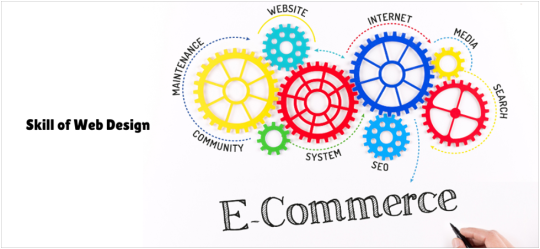
Attracts more people to your website
A well-designed website will rank higher in search results, increasing the number of individuals who may find and visit it. Web design and SEO should be considered equally and integrated in order to have a successful website. A few things that need to line up include search engine optimization (SEO), the website's content, responsiveness across various platforms, and the user experience.
It is easier for customers to do business with you when your website is well-designed.
A well-designed website should allow customers to transact business with you swiftly and effortlessly. This often indicates that users can quickly locate the information they need and may quickly contact you via phone or email. However, customers may get irritated and choose to conduct business with someone else if they are unable to locate information on your website or to do business with you.
In the competitive world of e-commerce, effective web design for e-commerce plays a vital role in establishing a solid online presence, enhancing user experience, and driving business growth. Visit Website :-
#graphicdesigningcourseinjaipur#webdesigningcourseinjaipur#photoshopcourseinjaipur#animationcourseinjaipur
0 notes
Text
The Importance of Logos for a Strong Brand Identity
The logo is a crucial component of your brand identification. A logo is a symbol that reflects your brand's essence, ownership, vision, and personality. Think about it. How many brands are you able to recognize simply by their logo? A well-designed logo becomes more than just decoration—it becomes an essential component of your brand's story.
A brand's logo can reveal much about its personality. Every logo component, such as the font, colours, and icons, is essential and purposefully used to set a specific mood.

The history of logo design can be found in ancient civilizations such as Egypt and China. The Chinese created characters representing words and concepts, while the Egyptians depicted their Pharaohs and gods with hieroglyphics. These ancient symbols first made the use of images to communicate meaning and identity possible.
Why do you need a logo? Because it draws attention, creates a lasting impression, forms the basis of your brand identity, is memorable, marks you apart from the competitors, encourages brand loyalty, and is something your audience expects. Visit Beyond Animation for a graphic designing course in Jaipur and learn how to make extraordinary logos.
Let's discuss the several ways a logo affects the success of your brand and explore the Importance of logos further.

What is a logo? - Importance of Logos
A logo combines text and graphic elements that serve two purposes. Some logos are strongly associated with people's memories on a symbolic level. For example, you may recognize that KFC represents the fast food chain without needing to read "KFC." That shows the Importance of logos.
Importance of Logos Creating a Powerful Logo -
Grabs Attention & Maintains Attention
Our attention spans are growing shorter; thus, designing your logo with this in mind is essential. If they remember your logo right away, it will be remembered. Within the first few seconds, if your logo is difficult to read, visitors will become uninterested. On the other hand, a well-designed logo can create a negative first impression, pushing potential customers away before they even give your brand a chance.
First Impression is Important
As your company's public face, your logo's design must provide a strong initial impression that reflects its Importance. Your logo should instantly convey your company's offerings to prospective customers as it serves as their initial point of contact with you. It must captivate, establish credibility, and educate to compel readers to ask more questions.

Makes You Stand Out from the Competition
You can see the Importance of logos when it separates you from your competition and grabs all your attention. Since your company is unique, you must ensure that the design of your logo is as well. Make a statement and explain to potential clients why your business is unique by using your Evolution of Logo Design. Your beliefs and mission are communicated, together with the details of your firm, when the appropriate icon, typeface, and colour scheme are used together. Dare to stand out from the crowd and convince them of your greatness.
Logo Increases Loyalty
Genuinely, logos increase brand loyalty. First views lead to impressions made, leading to a lasting impression, a desire to try, and a positive experience following purchase, retention, and loyalty.
How do I get the logo - Importance of Logos
The best way to get a logo is to be professionally designed by professional graphic designers. Despite the availability of inexpensive online logo design services, we have found that small local print and graphic design firms offer the best value and quality of service. Choosing a small freelance graphic designer or a print shop with an in-house designer can save you thousands of rupees compared to giant design firms or advertising agencies while still providing you with a high-quality logo and personalized service. You can get exceptional rates by hiring these tiny design services to create your business cards, stationery, and logo. You can get the best deals. You may also master brand consistency with this.

Impact of Bad Logo - Importance of Logos
If customers aren't on board or don't understand the purpose and what it means for the brand, customer detachment can be bad for brand loyalty.
Here are some points that make a logo bad:
Overly weird
Too artsy and complicated
Poor colour selection & shapes
The challenge to read all at once
difficult to identify letters
It is highly similar to another logo
too often changes (too hard to build loyalty)
Not in keeping with the message of the brand

Essential Elements of Logo - Importance of Logos
A few elements should work together while choosing how to design a logo to establish your unique style. While some logos use every element, others only use some of them. Understanding these concepts is critical to selecting the one that will work best for your business, regardless of which one you decide to incorporate into your logo. The secret to a great logo is to keep it basic and attempt to convey the essence of your brand. To stay up to date and get ideas, you should be informed of current trends in logo design process. While adding the newest trends to your logo could seem like a brilliant idea, you should first think about whether that design will be able to evolve with your business and stay current over time.
Conclusion - Importance of Logos
In branding, a logo is essential for all companies, regardless of size. Paying attention to emotional connection, distinction and brand awareness is important for the overall success. We cant overestimate the Importance of logo since it helps a business stand out in a competitive market, develop brand identification, and build confidence. Companies that invest in creating a solid logo strategy will benefit from having a strong brand presence that appeals to their target market. Visit Website :-
#graphicdesigningcourseinjaipur#webdesigningcourseinjaipur#photoshopcourseinjaipur#animationcourseinjaipur
0 notes
Text
A Guide to Graphic Design for Beginners | Elements & Principle,Tools, Role
Theory of Graphic Design
A Guide to Graphic Design for Beginners | Elements & Principle,Tools, Role
The art of visual communication using typefaces, layouts, and pictures is known as graphic design. In the context of graphic design theory refers to a framework that guides designers in figuring out how best to use images to convey ideas to audiences. Graphic design is everywhere nowadays. Everything from the stylish logos of your favorite companies to the eye-catching packaging of everyday products. For beginners venturing into the world of graphic design, understanding its theory is essential to mastering its practice. Entering the world of graphic design might be considered entering into a huge and unknown environment. Do not be worried! Your map will be this guide. Guiding you through the fundamental ideas that drive successful graphic design and providing you with the skills necessary to produce powerful images and learn graphic design easily.
Elements and Principles of Graphic Design for beginner’s
Graphic design is based on two main pillars: elements and principles; just like a structure needs a solid foundation; similarly, graphic design needs elements and principles. If you are willing to do a graphic designing course in jaipur at an affordable price beyond animation is the best place, offers you an elite learning experience.
Elements of Graphic Design for Beginners
Line: The simplest element, lines can convey a multitude of emotions and meanings. Subtle lines give a sense of peacefulness, while bold lines might convey a sense of urgency. You may draw the viewer's attention and enhance the visual appeal of your design by experimenting with different line weights and opinions. This will be helpful for graphic design for beginners.
Shape: For graphic design for beginners, Shapes create recognizable forms and add visual interest to your composition. Geometric shapes like squares and circles offer stability and structure, while organic shapes like leaves and clouds convey a sense of fluidity and movement. Understanding how different shapes interact with each other is crucial for creating visually balanced and engaging designs.
Color: In graphic design color is a very powerful tool. It evokes emotions, influences perception, and helps create a visual hierarchy. As a beginner in graphic design, It's essential to learn the fundamentals of color theory. Consider the color wheel, color harmony, and color psychology when selecting and using colors in your designs.
Texture: Texture gives your design depth and visual dimension. It might be something visible, like a fabric's design, or something real, like the roughness of paper. Textures may improve the overall visual experience and offer a hint of reality. This skill is important for graphic design for beginners.
Space: Negative or white space is just as important as the actual parts. It allows elements to breathe, preventing the design from feeling cluttered, and guides the viewer's eye through the composition. Mastering the use of space is a crucial skill for graphic design for beginners.
Principles of Graphic Design for Beginners
Balance: Balance creates a sense of visual stability and prevents the design from feeling off-center. Symmetrical and asymmetrical balance are both effective tools in a graphic designer's collection, depending on the desired message and overall composition.
Contrast: Contrast highlights important components in your design and adds visual interest. You may do this using texture, value, color, or size. Gaining attention and directing the viewer's eye need an understanding of effective contrast. Knowledge of contrasts is a must for graphic design for beginners.
Repetition: Repetition creates a sense of unity and visual rhythm. Using repeated elements like patterns or colors can enhance the design's overall impact and make it visually appealing. However, it's important to avoid extra doing it, as too much repetition can become unexciting.
Proportion: The connection between various design aspects is referred to as proportion. A composition that is harmonic and pleasing to the eye is ensured by using the right proportions. Understanding how different elements scale and interact with each other is a valuable skill for graphic design for beginners.
Graphic Design Beginners Tool
Understanding the theory is crucial to learn graphic design for beginners to advance, application of such information requires the appropriate gear. Fortunately, you can get assistance on your path from a number of software applications and resources:
Adobe Creative Suite: Industry-standard software like Photoshop, Illustrator, and InDesign provides a comprehensive toolkit for image editing, vector creation, and layout design. While these programs offer a wide range of functionalities, new users may find the learning curve more challenging. Learn photoshop through a dedicated photoshop course in jaipur by beyond animation
Canva: A user-friendly online platform, Canva offers drag-and-drop tools and pre-made templates, making it a great choice for graphic design beginners. It offers an intuitive user interface and lets you make eye-catching designs without requiring a lot of technical knowledge.
The Role of Graphic Design for Beginners
There are many uses for graphic design. Graphic design to, professional graphic designers, branding and advertising to journalistic layout, and user interface design are very important. Let's explore some of the applications where graphic design plays a significant role in creating impactful visuals:
Branding: Graphic design is essential for establishing and maintaining a brand's visual identity. Logos, color schemes, and overall brand aesthetics are carefully crafted to create a recognizable and cohesive brand identity. By utilizing graphic design principles, companies can effectively communicate their values and stand out from competitors.
Advertising and Marketing: The foundation of every effective marketing or advertising effort is graphic design. Graphic design is used to make compelling print ads, captivating social media visuals, and eye-catching posters. It also helps capture attention, deliver important messages, and change customer behavior. Make a career in video editing through a video editing course in jaipur, visit beyond animation website for more information.
User Interface (UI) Design: In the world of technology, website layouts, to mobile app designs, graphic design plays a key role in producing user interfaces that are both visually beautiful and clear. A successful digital product must have an understanding of how to build user-friendly interfaces that improve usability and promote good user experiences.
Graphic Design for Beginners’ Conclusion:
As a graphic designer beginner, If you are just starting, learning the theory and fundamentals of graphic design will provide you with a strong starting point for your career in this exciting industry. Always use the fundamental components of graphic design—color, typography, layout, and composition—while keeping in mind their significance and intent.
Remember, graphic design can seem overwhelming in starting. Still, with practice and a solid understanding of the theory, you will develop the skills and confidence to create stunning visuals that effectively communicate your ideas and messages.
0 notes
Text
A Guide to Graphic Design for Beginners | Elements & Principle,Tools, Role
A Guide to Graphic Design for Beginners | Elements & Principle,Tools, Role
The art of visual communication using typefaces, layouts, and pictures is known as graphic design. In the context of graphic design theory refers to a framework that guides designers in figuring out how best to use images to convey ideas to audiences. Graphic design is everywhere nowadays. Everything from the stylish logos of your favorite companies to the eye-catching packaging of everyday products. For beginners venturing into the world of graphic design, understanding its theory is essential to mastering its practice. Entering the world of graphic design might be considered entering into a huge and unknown environment. Do not be worried! Your map will be this guide. Guiding you through the fundamental ideas that drive successful graphic design and providing you with the skills necessary to produce powerful images and learn graphic design easily.
Elements and Principles of Graphic Design for beginner’s
Graphic design is based on two main pillars: elements and principles; just like a structure needs a solid foundation; similarly, graphic design needs elements and principles. If you are willing to do a graphic designing course in jaipur at an affordable price beyond animation is the best place, offers you an elite learning experience.
Elements of Graphic Design for Beginners
Line: The simplest element, lines can convey a multitude of emotions and meanings. Subtle lines give a sense of peacefulness, while bold lines might convey a sense of urgency. You may draw the viewer's attention and enhance the visual appeal of your design by experimenting with different line weights and opinions. This will be helpful for graphic design for beginners.
Shape: For graphic design for beginners, Shapes create recognizable forms and add visual interest to your composition. Geometric shapes like squares and circles offer stability and structure, while organic shapes like leaves and clouds convey a sense of fluidity and movement. Understanding how different shapes interact with each other is crucial for creating visually balanced and engaging designs.
Color: In graphic design color is a very powerful tool. It evokes emotions, influences perception, and helps create a visual hierarchy. As a beginner in graphic design, It's essential to learn the fundamentals of color theory. Consider the color wheel, color harmony, and color psychology when selecting and using colors in your designs.
Texture: Texture gives your design depth and visual dimension. It might be something visible, like a fabric's design, or something real, like the roughness of paper. Textures may improve the overall visual experience and offer a hint of reality. This skill is important for graphic design for beginners.
Space: Negative or white space is just as important as the actual parts. It allows elements to breathe, preventing the design from feeling cluttered, and guides the viewer's eye through the composition. Mastering the use of space is a crucial skill for graphic design for beginners.
Principles of Graphic Design for Beginners
Balance: Balance creates a sense of visual stability and prevents the design from feeling off-center. Symmetrical and asymmetrical balance are both effective tools in a graphic designer's collection, depending on the desired message and overall composition.
Contrast: Contrast highlights important components in your design and adds visual interest. You may do this using texture, value, color, or size. Gaining attention and directing the viewer's eye need an understanding of effective contrast. Knowledge of contrasts is a must for graphic design for beginners.
Repetition: Repetition creates a sense of unity and visual rhythm. Using repeated elements like patterns or colors can enhance the design's overall impact and make it visually appealing. However, it's important to avoid extra doing it, as too much repetition can become unexciting.
Proportion: The connection between various design aspects is referred to as proportion. A composition that is harmonic and pleasing to the eye is ensured by using the right proportions. Understanding how different elements scale and interact with each other is a valuable skill for graphic design for beginners.
Graphic Design Beginners Tool
Understanding the theory is crucial to learn graphic design for beginners to advance, application of such information requires the appropriate gear. Fortunately, you can get assistance on your path from a number of software applications and resources:
Adobe Creative Suite: Industry-standard software like Photoshop, Illustrator, and InDesign provides a comprehensive toolkit for image editing, vector creation, and layout design. While these programs offer a wide range of functionalities, new users may find the learning curve more challenging. Learn photoshop through a dedicated photoshop course in jaipur by beyond animation
Canva: A user-friendly online platform, Canva offers drag-and-drop tools and pre-made templates, making it a great choice for graphic design beginners. It offers an intuitive user interface and lets you make eye-catching designs without requiring a lot of technical knowledge.
The Role of Graphic Design for Beginners
There are many uses for graphic design. Graphic design to, professional graphic designers, branding and advertising to journalistic layout, and user interface design are very important. Let's explore some of the applications where graphic design plays a significant role in creating impactful visuals:
Branding: Graphic design is essential for establishing and maintaining a brand's visual identity. Logos, color schemes, and overall brand aesthetics are carefully crafted to create a recognizable and cohesive brand identity. By utilizing graphic design principles, companies can effectively communicate their values and stand out from competitors.
Advertising and Marketing: The foundation of every effective marketing or advertising effort is graphic design. Graphic design is used to make compelling print ads, captivating social media visuals, and eye-catching posters. It also helps capture attention, deliver important messages, and change customer behavior. Make a career in video editing through a video editing course in jaipur, visit beyond animation website for more information.
User Interface (UI) Design: In the world of technology, website layouts, to mobile app designs, graphic design plays a key role in producing user interfaces that are both visually beautiful and clear. A successful digital product must have an understanding of how to build user-friendly interfaces that improve usability and promote good user experiences.
Graphic Design for Beginners’ Conclusion:
As a graphic designer beginner, If you are just starting, learning the theory and fundamentals of graphic design will provide you with a strong starting point for your career in this exciting industry. Always use the fundamental components of graphic design—color, typography, layout, and composition—while keeping in mind their significance and intent.
Remember, graphic design can seem overwhelming in starting. Still, with practice and a solid understanding of the theory, you will develop the skills and confidence to create stunning visuals that effectively communicate your ideas and messages.
0 notes
Text
Beyond Animation India’s Leading Graphic design institute | Graphic Designing Course in Jaipur
Beyond Animation is a leading institute of Graphic designing course offering top-notch courses. We provide comprehensive graphic and web design training, preparing students for successful careers in the IT industry. Our institute boasts a track record of nurturing talent across various fields, including 2d Animation & Multimedia, Website Design, Graphic designing course in jaipur, Audio-Video Editing, Character Design, Vector Graphics, Adobe Premiere Pro, Digital Illustration, Adobe Illustrator, Animation, Adobe InDesign, Photography Course In Jaipur, and CorelDraw.
Our highly skilled instructors ensure students gain practical experience through real-world projects, empowering them to succeed in the ever-evolving IT industry. Our curriculum is revised frequently to meet the market's and Google's needs, ensuring that our students stay ahead of the curve. A practice studio and classroom with a modern theatre atmosphere are features of the Jaipur-based institution Beyond Animation. Highly skilled teachers provide excellent educational experiences.
In addition to your course certificate, we provide a six-month working experience certificate with our design firm that eliminates the "fresher" label. Please visit our classes and discover the possibilities for a fulfilling career after serving in Jaipur for the last two years. Come along with us at Beyond Animation and begin your path to success.Visit Website:-https://beyondanimation.in/

1 note
·
View note